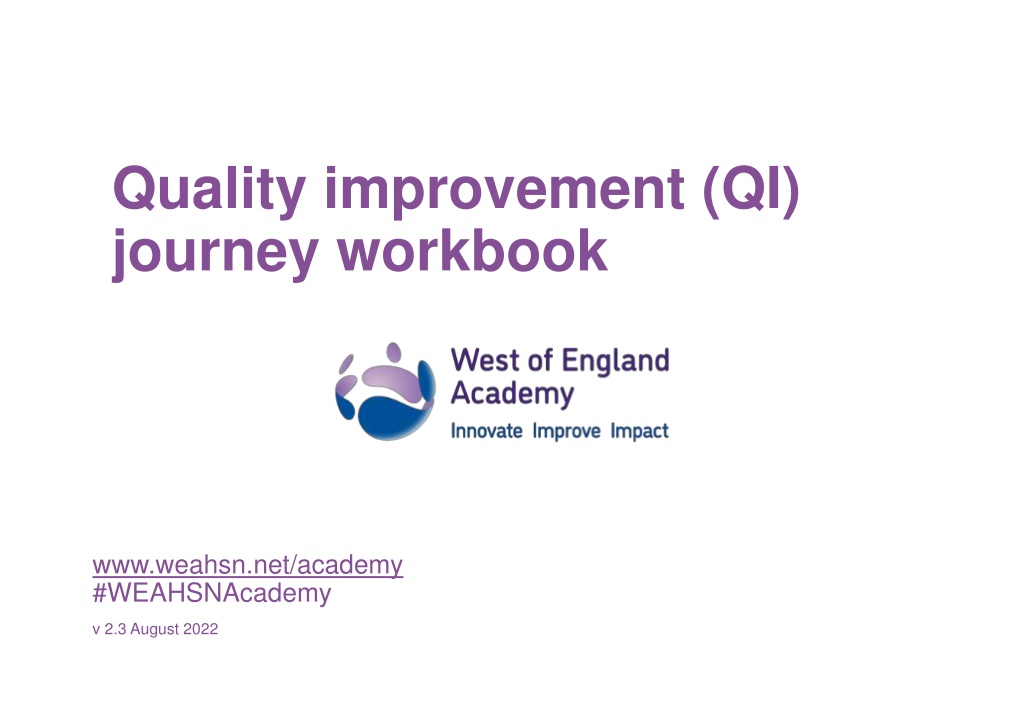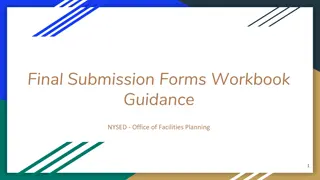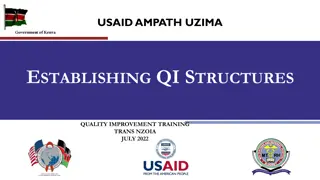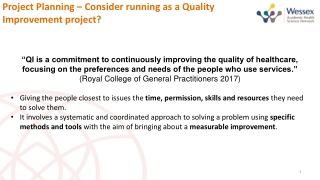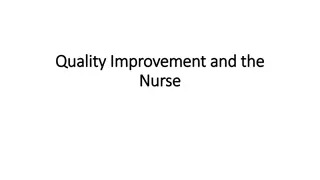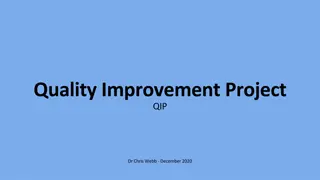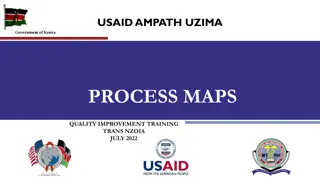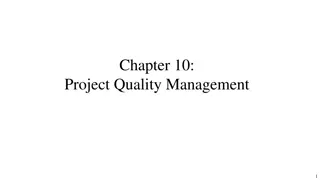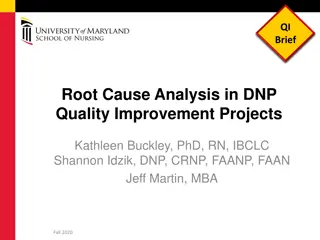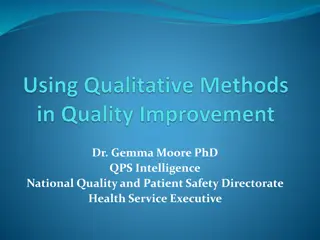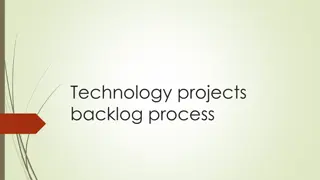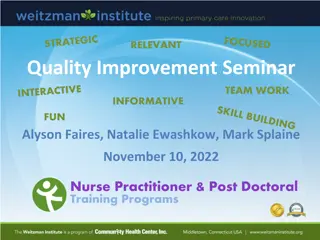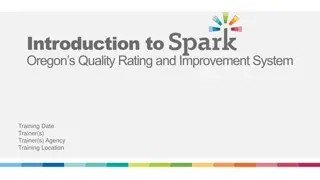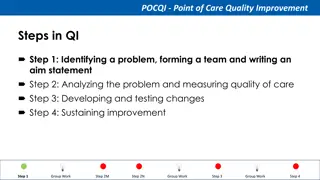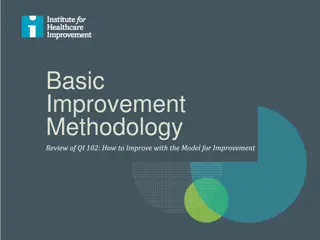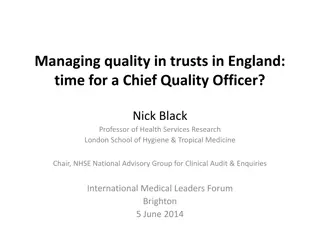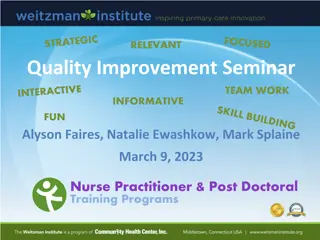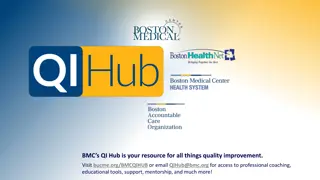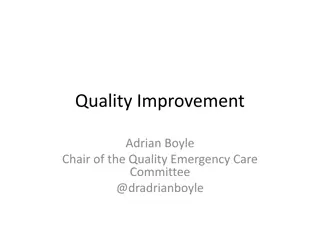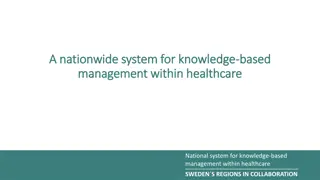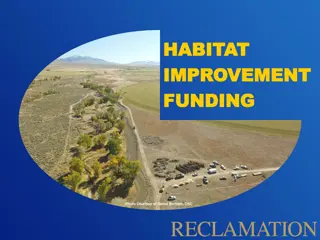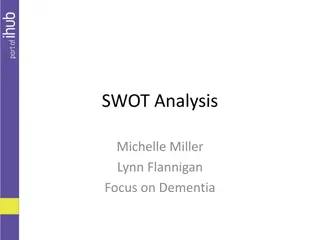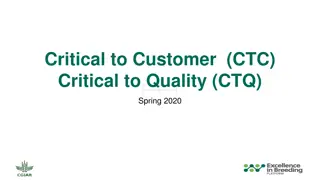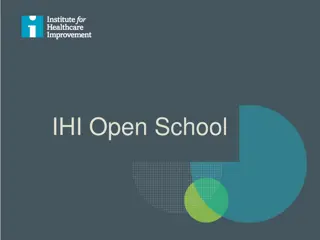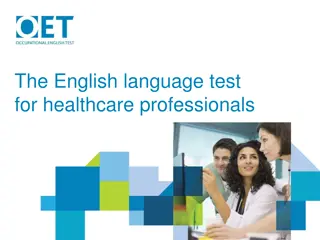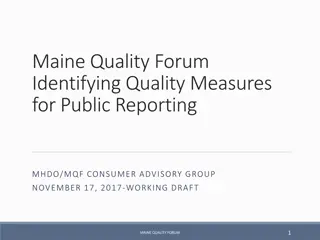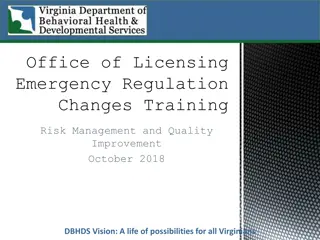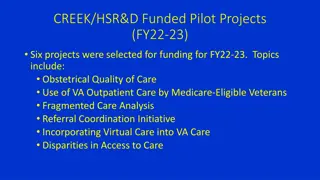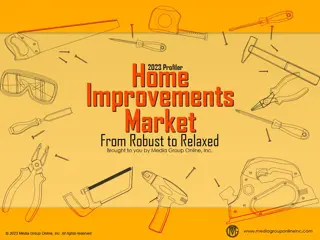Quality Improvement Workbook for Healthcare Projects
The Quality Improvement (QI) Journey Workbook provided by the West of England Academy is a valuable collection of worksheets designed to assist individuals in structuring and guiding simple QI projects in a healthcare setting. This practical resource covers various stages of a QI project, from identifying challenges to implementing change ideas and sharing learnings. It emphasizes the importance of stakeholder involvement and offers tools and templates to streamline the improvement process. Ideal for both QI beginners and experienced professionals, this workbook serves as a comprehensive guide to fostering quality improvements in healthcare delivery.
Download Presentation

Please find below an Image/Link to download the presentation.
The content on the website is provided AS IS for your information and personal use only. It may not be sold, licensed, or shared on other websites without obtaining consent from the author. Download presentation by click this link. If you encounter any issues during the download, it is possible that the publisher has removed the file from their server.
E N D
Presentation Transcript
Quality improvement (QI) journey workbook www.weahsn.net/academy #WEAHSNAcademy v 2.3 August 2022
2 What is the workbook? The workbook is a collection of worksheets that can be used to help structure and guide a simple quality improvement (QI) project. We recommend you start at the beginning and work your way through each activity or use the contents page to navigate your journey. Why would I want to use the workbook? We know that running a QI project can sometimes be complicated and confusing. We hope that this workbook will provide practical, simple support to guide you through the process. Watch this video to understand how QI tools can be used in a real healthcare improvement project. Who is the workbook for? The workbook has been designed to help people that are running a QI project in a healthcare setting. If you are new to QI then do check out our on- demand QI training. This workbook is structured and colour-coded to help you design a QI poster or write an improvement report to share the learning from your project. Some worksheets can be completed by one person, but the majority will need completing as part of a team-based activity with a mix of people involved in your project work. Involving your stakeholders (people impacted by the changes you ll be making) in these activities will significantly help your project to be a success. Check out our guide to creating a QI poster for more information and once you have created your poster please share it with others on our Evidence Repository. The West of England Academy offers a wide range of free resources to healthcare professionals and innovators across the region. To find out more, visit our website or email weahsn.academy@nhs.net West of England Academy Quality Improvement Workbook
3 Stage QI Tools Poster sections Page Contents 5 Whys Stakeholder analysis Project mapping Background / Problem/ Issues Understand the challenge 5-11 1 Model for improvement SMART target Set a SMART target Aim 12-14 2 What are we trying to accomplish? Sources of data collection Outcome, Process and Balancing measures Operational definitions Identify your measures Results/ data 15-18 3 How will we know that a change is an improvement? Greenhousing TRIZ MOSCOW Create and select change ideas 19-24 4 What changes can we make that will result in improvement? Driver Diagram Communication Plan Project check-in Method/Strategy for Change Plan the project 25-30 5 Conclusions/ Lessons Learned Test change ideas Act Plan PDSA Learning Log 31-33 6 Study Do Poster template SQUIRE template Sharing your learning 34-38 West of England Academy Quality Improvement Workbook
The table below uses colour to show the different sections of the QI Poster Template and how they relate to the stages of your QI journey through this workbook. 4 Project Title People involved Background/Problem/Issue Results/Data Aim Image/Chart Conclusions/Lessons Learned Method/Strategy for Change West of England Academy Quality Improvement Workbook
5 Stage 1: Understand the challenge It is important to take the time to fully understand the problem you are trying to solve. Stakeholders are everyone involved, interested in and benefiting from your project work. Understanding and engaging with your stakeholders is crucial to the success of your project as they can be champions of your work or create barriers. Complete 5 Whys, stakeholder mapping and process mapping. If you skip this stage, you might waste time making a solution that doesn t solve your issue. Use the stakeholder facilitator slides to help facilitate mapping as a team activity. For more detail on the tool, please visit the relevant page in the toolkit Process mapping can be used to demonstrate the: Current way of working to identify areas for improvement, for example where the same activity is repeated unnecessarily or where there is a bottle neck . At the end of this stage you will have the information you need for your poster on the Background/ Problem/ Issue. Background/Problem/Issue Results/Data Aim Image/Chart A new improved process, for example you can map what the process would look like if you changed it in some way. Use the process mapping facilitator slides to help facilitate this as a team activity. For more detail on the tool, please visit the relevant page in the toolkit. Conclusions/Lessons Learned Method/Strategy for Change About the tools: 5 Whys is a simple tool to help you start to identify the root cause of a problem. Use the 5 Whys facilitator slides to help facilitate this as a team activity. For more detail on this tool, please visit the relevant page in the toolkit West of England Academy Quality Improvement Workbook
6 Quality improvement tool: 5 Whys Step 2: Ask someone else, or yourself, why? Why is that happening? Why is that? Why is that? Why is that? Step 3: Can you redefine the problem? What do you think the problem is? Step 1: What do you think the problem is? Example: West of England Academy Quality Improvement Workbook
7 5 Whys Template What do you think the problem is? Why? Why is that happening? Why is that? Why is that? Why is that? Can you redefine the problem? What do you think the problem is? West of England Academy Quality Improvement Workbook
8 Quality improvement tool: Stakeholder mapping Step 1: Who are your stakeholders? Make a list of the obvious people Refine your list by using the following (QSIR NHS E/I): Commissioners Customers Collaborators Contributors Channels Commentators Consumers Champions Competitors Step 2: What type of stakeholder are they? Map your stakeholders on to the chart (see next slide). QSIR NHS E/I Now that you understand who your stakeholders are you can appropriately involve them in your QI project at the relevant stages. When you know your project objective and the changes you ll be testing, you ll need to think about how you will communicate with your stakeholders throughout the project. We ll look later at creating a communications plan. It is really important to think about how you can involve patients and families in your project right at the start. Step 3: Create a user persona for key stakeholders What do you know about them? How do they interact with the service/product? How do they communicate? communications plan West of England Academy Quality Improvement Workbook
9 Stakeholder mapping template Low interest High interest Keep satisfied Manage closely High power Monitor (minimum effort) Keep informed Low power West of England Academy Quality Improvement Workbook
10 Quality improvement tool: Process mapping Questions to consider with your team before starting: Use these symbols to plot the process: Box: shows the activities of the process. What is the aim for this process mapping exercise? Diamond: represents the stage in the process where a question is asked, or a decision is required. Oval: shows the start of a process and the inputs required and the end of the process with the outputs. Arrows: show the direction of the process. What is the start and the end of the process you are mapping? Do you have everyone involved in the process taking part? Can you map this process in one session, or should you chunk it? If you are drawing a process map in PowerPoint look for the green anchor points when attaching arrows, as these will connect things up and keep the arrows with the right boxes when you move things around. West of England Academy Quality Improvement Workbook
11 Process mapping template Draw your process map here West of England Academy Quality Improvement Workbook
12 Stage 2: Set a SMART Target A SMART target will help everyone involved in your project understand and agree what your objective is, it doesn t leave any room for confusion or misunderstanding. Using a SMART target will help define the scope of your project and make your project measurable. Use the SMART Target facilitator slides to help facilitate this as a team activity. For more detail on the tool visit the relevant page in the toolkit. Consider your general aims for the project. e.g. Improve community rehabilitation rates ...and refine the sentence so it s SMART e.g. Ensure that all patients are seen within 4 weeks of referral for community rehabilitation by October 2022. Background/Problem/Issue Results/Data At the end of this stage you will have the information you need for your poster on the Aim. Aim Image/Chart Conclusions/Lessons Learned Method/Strategy for Change West of England Academy Quality Improvement Workbook
13 Quality improvement tool: SMART Target Step 2: Discuss these questions with your team: Key terms: Are the key terms defined clearly? Scope: What is the scope of the improvement? Which patients, services, locations etc. are included or excluded? Timescales: How good, by when? When is the improvement intended to happen by? What is the scale of the improvement? Constraints: What are the constraints on how the improvement is undertaken? What don t you want to accidentally make worse? Measurement: How will the improvement be measured? No solution: Does the aim include the solution? (It shouldn t) Step 3: Rewrite your target, using the SMART acronym below as a guide Specific have you been specific about what you want to improve? Step 1: What is your general aim for the project? The SMART target for the QI project is: Measurable have you included a numerical target? Achievable is it achievable? Relevant does it relate to patient outcomes? can you link it to the strategic aims of your organisation? Time-bound have you included a timeframe for the project? West of England Academy Quality Improvement Workbook
14 SMART Target template What is your general aim for the project? Specific have you been specific about what you want to improve? Measurable have you included a numerical target? Achievable is it achievable? Relevant does it relate to patient outcomes? can you link it to the strategic aims of your organisation? Time-bound have you included a timeframe for the project? The SMART target for the QI project is: West of England Academy Quality Improvement Workbook
15 Stage 3: Identify your measures To ensure the changes you are making are improving the situation, you will need to collect some data. If you have evidence that your QI project has worked then you will be more likely to secure funding to sustain the changes. The data doesn t need to be complicated, keep it simple and easy to collect. This stage can be a bit iterative, and it make take a few tests of change to get the measures right so don t worry if you don t get it right first time. Remember to seek usefulness, not perfection, in the measurement (Nelson et al, 1998). Use the sources of data collection, operational definitions and outcome, process and balancing measures facilitator slides to help facilitate these activities with your team. For more details on these activities, please visit the relevant page in the toolkit. Also ask yourself: At the end of this stage you will have a plan for collecting the data for your results section of your poster and you may have some idea of how you will present your data as an image or chart. Where will you review and discuss your data as a team? How will you share and celebrate success? Background/Problem/Issue Results/Data Aim Image/Chart Conclusions/Lessons Learned Method/Strategy for Change West of England Academy Quality Improvement Workbook
16 Identifying your measures Step 3: Use these prompts to consider more sources and types of data: Qualitative, quantitative, patient level, service level, organisational level, population health level, routinely collected data Step 2: What are your initial ideas on the data that might help with your project? e.g., how to understand the problem and how to measure improvement. Step 1: Your project objective: Step 5: Use the prompts below to consider if your measures are clearly defined: Be aware of areas of subjectivity, could someone else misunderstand them? Always define what is correct and what is incorrect. If a visual check of pass/fail is required, your operational definition could include photographs. Test the operational definition to make sure it produces consistency. Can you improve the definitions in Step 4? Step 4: In your data above identify measures for your project. Outcome (x1) linked explicitly to the aim of the work: Process (x2+) linked to the changes you are going to work on to achieve your aim: Balancing (x2+) unintended consequences, good/bad: Step 6: As you collect the data consider how to present and share it. West of England Academy Quality Improvement Workbook
17 Defining your measures template Outcome Process Balancing Qualitative What is being measured? Who does it measure? When does it measure it? How often is it measured? Who collects it? Does it measure absolute numbers or proportions? Where does the data actually come from? How accurate and complete will the data be? Are there any caveats/ warnings/ problems? Comments/ notes West of England Academy Quality Improvement Workbook
18 Representing data on charts Or an infographic, for example: As you collect the data consider how to present and share it. You could use a run chart for example: Ref: https://www.iecodesign.com/blog/2015/2/2/run-charts-in- quality-improvement-work There is a section for adding images and charts on the poster template: Find out more about making infographics by watching our short video. Background/Problem/Issue Results/Data Our QI on-demand training includes bonus sessions on how to collect and present data. Aim Image/Chart Plot the Dots/Making Data Count from NHS England are really useful guides and include templates to make charts from your data. Conclusions/Lessons Learned Method/Strategy for Change West of England Academy Quality Improvement Workbook
19 Stage 4: Create and select change ideas Our Creative Problem Solving Toolkit has lots of other tools to help you through the creative problem solving process. Don t jump to the obvious ideas to test, take some time with your team to think creatively about ways to reach your project objective. Use the greenhousing and TRIZ facilitator slides to help facilitate these activities with your team. or more details on these activities, please visit the relevant pages in the toolkit. If you need to prioritise your ideas, you can use MOSCOW to separate them into the things you must do, should do, could do, or won t do. At the end of this stage you will have some ideas for how you can plan your approach to change and this will help you put together your Method/ Strategy for Change in the next stage. Background/Problem/Issue Results/Data Aim Image/Chart Conclusions/Lessons Learned Method/Strategy for Change West of England Academy Quality Improvement Workbook
20 Quality improvement tool: Greenhousing Greenhousing techniques can be used to create the ideal conditions for sharing and developing new ideas. When new ideas are shared, they can be fragile and need growing and developing in a safe space. To prevent ideas being created: React straight away Assume you know everything about the idea INsist you are right In your creativity session use phrases such as: Tell me more let me understand I m just going to have think about that The SUN and RAIN model is from the book Sticky Wisdom. What s the big idea behind this idea How else could we do this? Maybe we could take that idea and do this I like that, we could do that and then To support ideas being created: Suspend your judgement Understand what s in front of you Nurture the idea West of England Academy Quality Improvement Workbook
21 Change ideas template Write your ideas here West of England Academy Quality Improvement Workbook
22 Quality improvement tool: TRIZ Use TRIZ, a Liberating Structure, with greenhousing techniques to help your team be creative. Follow these steps and complete the template. If you enjoyed TRIZ, you might like to try other Liberating Structures: https://www.liberatingstructures.com/ Step 2. Flip the project objective on its head to make it the worst-case scenario objective Step 3. Describe what would happen if this worst- case scenario came true. Step 1. Write down your project objective Step 6. Think creatively for how you can reduce/stop these unwanted activities or behaviours. Nurture these ideas using the SUNny language. Step 4. Make a list of all the things you can do to ensure you achieve the worst-case scenario. Step 5. Highlight the items on this list that are currently being done. Be honest! West of England Academy Quality Improvement Workbook
23 TRIZ Template Project objective TRIZ objective Describe the worst case scenario What things can you do to ensure the worst case scenario? Ideas for stopping unwanted activities (let the SUN in!) Tick if this happens West of England Academy Quality Improvement Workbook
24 MOSCOW template Must do Could do Should do Won t do West of England Academy Quality Improvement Workbook
25 Stage 5: Plan the project It is important to take the time to plan your improvement project, this allows you to consider the impact of your project and it s helpful having documentation to share with people who are interested in your work. Planning can be a relatively quick exercise as a lot of the elements will already be thought through. About the tools: A driver diagram is used to plan and map out your improvement project, it is beneficial to see your project on one page and to understand how your change ideas connect to your project objective. Work with the project multi-disciplinary team to complete the driver diagram template on page 20. At the end of this stage you will have the information you need for your poster on the Method/ Strategy for Change. Use the driver diagram facilitator slides to help facilitate this team activity. For more detail on the tool, please visit the relevant page in the toolkit. A simple communications plan maps out your key messages and how you will share these with your different stakeholder groups. Background/Problem/Issue Results/Data Aim Image/Chart There is also a quick project check-in template to discuss with your team to help you finalise your plans. Conclusions/Lessons Learned Method/Strategy for Change West of England Academy Quality Improvement Workbook
26 Quality improvement tool: Driver diagram Questions to consider before starting: What is your project objective? What are the overarching primary drivers that will help you meet the objective? Can these primary drivers be broken down further into secondary drivers? ri er ia ra s What are your measures? A AS R MAR R RS S AR R RS A M ind out the relevant code romote the use of the code at training sessions Improving identification of pregnant women that smoke Improve coding ink with community midwives data share ontact the lead of your local community midwife service To decrease of pregnant women smoking by by April ind out what current services are available for smoking cessation and signpost women to these ink with community midwives and educate staff on resources available ducate pregnant women about the dangers of smoking Improve availability of leaflets and posters in waiting rooms and website Improve local literature to educate women on the dangers of smoking ducate staff on how to discuss smoking cessation and resources available Ask every pregnant woman if they smoke Make every contact count West of England Academy Quality Improvement Workbook
27 Driver diagram template Primary Drivers: System components which will contribute to meeting the project objective Secondary Drivers: Elements of the associated primary driver. They can be used to create projects or change packages that will affect the primary driver Change ideas A P S D A P SMART Objective S D A P S D Measures: Process measure(s): Outcome measure(s): A P Balancing measure(s): S D West of England Academy Quality Improvement Workbook
28 Quality improvement tool: Communications plan Knowing who your stakeholders are and including them in your project work is crucial for the success of your QI project. You will want to keep them updated/involved/engaged as the project progresses. Some example project logos: Use this simple communications plan to map out your key messages and how you will share these with your different stakeholder groups. PreciSSIon (Preventing Surgical Site Infection across a region) reating a brand for your project can help get people involved and excited about your work. Communications plan Objectives (for the comms plan) Key Messages (to be communicated out) Target Audiences and Channels Branding Black Maternity Matters Project name/logo (get creative!): Remember to talk to your comms team about this Organisation logos to include in comms: West of England Academy Quality Improvement Workbook
29 Communications plan template Communication channel and regularity (e.g., monthly direct email and weekly department briefings) Key messages Stakeholder group Role in your project West of England Academy Quality Improvement Workbook
30 Project check in template Where are you now? What are your plans? What are your challenges? Which change ideas are you planning to test? Why have you selected them? How have you assigned the testing of change ideas? What has gone well in relation to change ideas? What s difficult about selecting and testing change ideas? How might you overcome these barriers? What change ideas will you test next? Change Ideas Which PDSAs have you tested? Have you learnt anything from testing? How did you record your PDSA? Who has been involved in your testing? Have you used measurement to inform your PDSAs? How do you share your learning/outcomes from PDSA? What has been good about doing PDSA? What PDSAs are you planning to do? Who will test for you? Where will the tests happen? What s been challenging about PDSA? How might you overcome these barriers? PDSA What measures from your measurement plan are you using at project level? Consider; Outcome, Process, Balancing, Qualitative. How do you collect your measures? How are you presenting and sharing your measures? What is your data telling you so far? What has been positive about using measures? What has been challenging about measurement? How might you overcome these barriers? What are your plans related to measurement? Measurement How have you involved patients and families in your project? What strategies/approaches have you used? What have you learnt from involving patients and families? How will you be evaluating patient and family experience? What has been challenging about involving patients and families? How might you overcome these barriers? What are your plans for involving patient and families in the future? Involving patients West of England Academy Quality Improvement Workbook
31 Stage 6: Test change ideas A Plan Do Study Act (PDSA) cycle is the recommended model for testing changes from the Institute for Healthcare Improvement. The PDSA cycle guides you to make safe changes and facilitates a test and learn approach. PDSA cycles. At the end of this stage you will have the information you need for to write the section on Conclusions/ Lessons Learned for your poster. About the tool Background/Problem/Issue Results/Data Use the PDSA facilitator slides to help facilitate this as a team activity. For more detail on the tool, please visit the relevant page on the toolkit. Aim Image/Chart Conclusions/Lessons Learned Method/Strategy for Change Before you start a PDSA cycle you need to: Understand the problem and have set a SMART target Agree how to measure the impact of your project work Get creative and think f improvement ideas and record these ideas in your driver diagram. Once you have worked through these three steps, you are ready to start using the Plan Do Study Act cycle. Use the learning log template to record your West of England Academy Quality Improvement Workbook
32 Act Plan Learning Log template Study Do What will your test be? How could the issue be resolved? What could be introduced to make an improvement? Who is a useful contact to support you with this improvement? What data will you collect? Can you work with others to shape your improvement? What is your baseline measurement? What do you think will happen as a result of your test? Plan What happened when you carried out your test? What did the data show? Do How did the results of your test compare with predictions? Has the change been an improvement? Is there variation in the data? What have you noticed during the study period? What have you learnt from making this change? Do you have any tips for other improvers? Study Do you think there is still room for improvement? What will you do next? Will you adopt this change (keep it), adapt it for another cycle or abandon it (stop it). Act West of England Academy Quality Improvement Workbook
33 Act Plan Learning Log template Study Do Plan Do Study Act West of England Academy Quality Improvement Workbook
34 Sharing your learning Using the information you have entered into this workbook, you now have most of the important information needed to put together a poster! Check out our guide to creating a QI poster for more information and to download editable poster templates. You can use the colour-coding below to know what information goes where: Once you have created your poster please complete a cover sheet and share it with others on our Evidence Repository. Project Title People involved Background/Problem/Issue Results/Data Aim Image/Chart Conclusions/Lessons Learned Method/Strategy for Change Another way to share your findings is with a more detailed improvement report. The SQUIRE guidelines set out best practice in writing up quality improvement projects and the template on the next page shows how SQUIRE maps to the sections in this workbook. Before you start you might find it helpful to read some existing projects published in BMJ Quality Improvement Reports to understand how others have documented and structured their work. If you are a member of the Q community this comes with opportunities to publish your work. West of England Academy Quality Improvement Workbook
Project title People involved Background/Problem/Issue Results/Data ENTER TEXT HERE ENTER TEXT HERE Aim Image/Chart ENTER TEXT HERE ENTER TEXT HERE Method/Strategy for Change Conclusions/Lessons Learned ENTER TEXT HERE ENTER TEXT HERE
SQUIRE template mapped to the sections of this workbook 36 Indicate that the article concerns an initiative to improve healthcare Title This is a summary of your work and is the most important section to attract a reader's attention. Please ensure you include a brief background to the problem, the method for your quality improvement project, the overall results and conclusion. Keep it succinct and factual. Abstract In this section you will need to summarise your problem and the focus of your project. You will need to outline your SMART aim for your project (for example; the aim was to reduce medication errors from 15% to 5% across six elderly care wards in three months). Give some details about your local context including; the type of organisation you work in, the size of your organisation, details about the staff members who work there and perhaps a little bit about your local patient population. It might be useful for others to include how you got started with this project and what drove you to tackle this problem. Problem This section gives the reader background information about the problem and provides up-to-date, research and knowledge from the literature. Summarise the literature you have found on the background t your problem here. What existing evidence is there that this problem exists? What evidence is there that other people have tried to solve this problem in the past? Is there any evidence for what works and what doesn't to solve your problem? Background Describe which measures you selected for studying processes and the outcomes of the intervention(s), including rationale for choosing them, their operational definitions, and their validity and reliability. Describe how you planned to collect this data throughout your project and how frequently. Outline how you planned to establish if the observed outcomes were due to your interventions. You must also include here, the results of your baseline measurement. Measurement Describe the intervention (or series of interventions) that you planned to implement to improve the quality of care you deliver. Describe any reasons or assumptions that were used to develop the intervention(s) and reasons why you expected them to work. Outline how you consulted/engaged with your team members or organisations. Who was in your project team? Did you anticipate/predict any problems at this stage? Describe how you planned to make your intervention sustainable. This step is critical for others to understand the thinking behind the development of your intervention. Design In this section you should explain your strategy for improvement to the reader and discuss how you implemented your improvement cycles. In most cases you will have tried a number of progressive improvement cycles, some of which will not have been successful. It is important that you also share these to help others avoid similar difficulties. Remember that data should be collected continuously throughout your project. This is a difficult section to document and will contain a lot of information. For each PDSA cycle you should describe your aim, your change hypothesis and strategy for change. Describe how you implemented the change and the data you collected. Describe your key learning from each cycle of change, and discuss how this learning impacted on your change process. How well did your predictions of what change was needed match your outcomes? What worked more effectively than anticipated and what had less effect than predicted? Strategy
SQUIRE template mapped to the sections of this workbook 37 Provide a summary of what your results and run-chart/control chart showed. Describe the variation in your data. Were the interventions you made responsible for any improvements? Describe how contextual elements interacted with the intervention(s) and affected your results. Compare your results to your baseline measurement. Comment on how you assessed whether the data was complete and accurate- was there any missing data? Please comment on whether there were any unintended consequences such as unexpected benefits, problems, failures or costs associated with the intervention(s). Results In this section, discuss the lessons you learnt from the project and its limitations. Comment on the strengths of the project. Describe any problems you faced and how you navigated these. If you were to undertake this project again, what would you do differently? Reflect on your project's limitations. For example, did you realise as the project was implemented that your results would be affected by unforeseen factors such as a small sample size or the turnaround of patients or staff? Comment on the limits of generalisability. Describe whether chance, bias, or confounding have affected your results and whether there was any imprecision in the design or analysis of the project. Are more data points required? Were efforts made to minimise/adjust for any limitations? Although we accept publications using different improvement approaches, we would expect you to have modified your intervention as it was implemented and undergone a process of continuous improvement, measurement and learning. If your project does not fit with this approach then we would like to see reflections and learning here about how you could have incorporated continuous improvement and measurement approaches in your project. Lessons and limitations You should reflect on your background research, noting what is already known on this topic and what your project adds. You should refer back to your aims statement did your project achieve its aims? Did you adjust your aims as you went along? Was it a useful project? Were your measures appropriate and did you use balancing measures? Think about what your senior sponsor would like to see as an output of your work and what can help others to make the case for undertaking a similar piece of work or for doing something differently if your project was not successful. Please describe your cost analysis here, were there any financial savings that your project made? Being able to demonstrate that your intervention delivered savings really helps to add value. Give an assessment of whether you think your project is sustainable- do you have enough data? What have you done to try to ensure that your work continues? Comment on how you would spread your project and whether it could be replicated elsewhere. Discuss what your next steps will be and whether further study in the field is required. The point of the conclusion is not to rewrite the whole project, but to give an overview of how the whole project was conducted, what it achieved, and some personal reflections. Conclusion In this section you should record any references to published material that you refer to elsewhere in your project. This is particularly likely to include material from background reading or from your conclusions. References Please include here the names of anyone who is not on the author list but whose input you wish to acknowledge. Acknowledgements
38 We hope this workbook has been helpful to facilitate your QI Journey. We d love to hear your questions or suggestions to make improvements. Contact us at weahsn.academy@nhs.net The West of England Academy offers a wide range of free resources to healthcare professionals and innovators across the region. To find out more, visit our website or follow our hashtag #WEAHSNAcademy on Twitter. Thank you. West of England Academy team. Created February 2022 Version 2.3 August 2022
